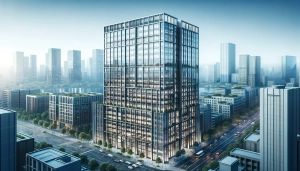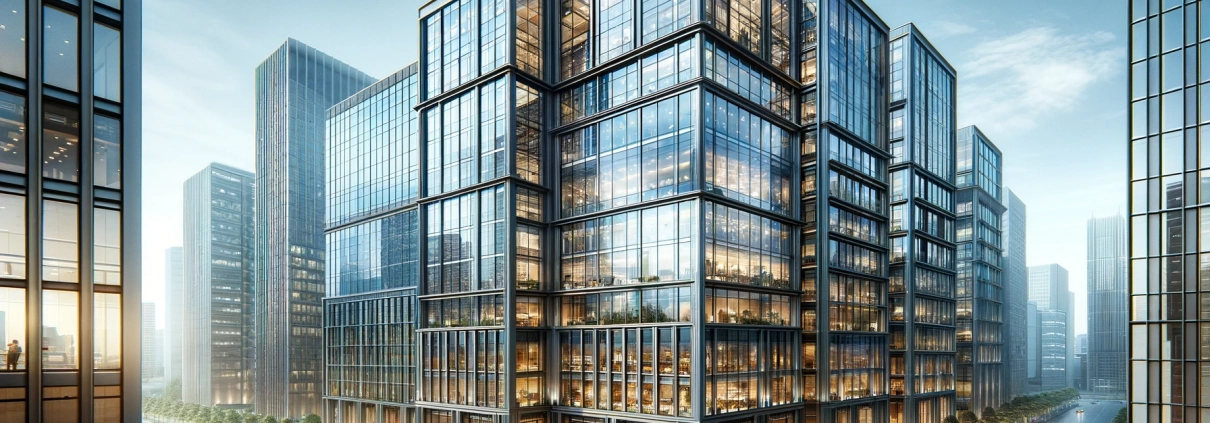Commercial Building Windows
Visionary Views: Navigating the World of Commercial Windows for Form, Function, and Sustainability
Table of Contents
Windows are the eyes of a commercial building, offering more than just a view; they symbolise the nexus between functionality and form, energy efficiency, and aesthetics, playing a significant role in the architectural identity of commercial space.

Design and Aesthetics
Trends in Commercial Window Design
The contemporary commercial landscape has seen a shift towards large, open windows that allow for an abundance of natural light and create a sense of openness and transparency. These expansive glass facades are not only about the visual appeal but also about how a building interacts with its surroundings, promoting a work environment that feels both connected and inviting.
Balancing Form and Function
While aesthetics is important, they must go hand-in-hand with functionality. The design of commercial windows must consider factors such as the direction of sunlight, prevailing winds, and the building’s usage to provide optimal comfort for its occupants. Effective window design can reduce the need for artificial lighting and heating, significantly impacting the building’s operational costs.
Impact of Window Design on Branding and Corporate Image
Windows also play a crucial role in branding. The architecture of a building, including its windows, can reflect a company’s ethos and values—be it transparency, innovation, or a commitment to sustainability. Thoughtful window design can therefore enhance a company’s public image and branding efforts.
Material Selection for Durability and Performance
Common Materials Used in Commercial Windows
Commercial windows are built to last, using materials that can withstand the rigours of the environment. Aluminium, vinyl, and wood are common choices, each offering distinct advantages in terms of strength, durability, and maintenance requirements.
Comparing Glass Types: Tempered, Laminated, and Insulated
The choice of glass is as critical as the frame. Tempered glass provides strength and safety, shattering into small, blunt pieces if broken. Laminated glass offers an additional layer of security and noise reduction, while insulated glass units (IGUs) are essential for thermal efficiency.
Frame Materials: Aluminium, Steel, and Composite Options
Frames give structure to windows, and in commercial settings, they must offer more than just support. Aluminium frames are lightweight and corrosion-resistant, steel frames provide unmatched strength, and composites can deliver a blend of durability and aesthetic appeal.
Energy Efficiency and Sustainability
Understanding U-Values and Solar Heat Gain Coefficients
The U-value measures how well a window prevents heat from escaping, while the Solar Heat Gain Coefficient (SHGC) indicates how much heat from the sun is admitted through the window. Both are key metrics in determining a window’s energy efficiency, and thus, they are crucial considerations for any commercial building.
Energy Star Ratings for Commercial Windows
Energy Star ratings help consumers and businesses compare the energy efficiency of different window products. Windows that earn the Energy Star label have been independently tested and certified to meet strict energy-efficiency standards set by the government.
Incorporating Sustainable Practices in Window Selection
Sustainability is not just a buzzword; it’s a commitment. Selecting windows that are not only energy-efficient but also manufactured sustainably and from recyclable materials can significantly reduce a building’s carbon footprint.
Technological Advancements in Commercial Windows
Smart Glass Innovations
The advent of smart glass technology marks a turning point in commercial window functionality. With the ability to transition from transparent to opaque at the flip of a switch, smart glass offers unparalleled control over privacy, lighting, and temperature, contributing to a building’s adaptability and energy conservation.
Automated Window Systems for Commercial Buildings
Automation has extended its reach to windows, with systems designed to open and close based on predetermined settings or in response to environmental triggers such as temperature or air quality. This integration with the building’s management system not only enhances the comfort of occupants but also optimises the building’s energy efficiency.
Integration with Building Management Systems
Modern commercial windows can be integrated into building management systems (BMS), allowing for a cohesive and centralised approach to a building’s operations. This integration can help in monitoring and adjusting to various factors, including security protocols, energy consumption, and even emergency responses.
Safety and Security Considerations
Importance of Safety in Commercial Window Design
Safety remains a top priority in commercial building design. Windows in these environments are required to meet strict building codes and standards to ensure they are resilient against both accidental breakage and potential security breaches.
Security Features in Window Construction
Advancements in window construction have led to the inclusion of various security features, such as reinforced frames, impact-resistant glass, and advanced locking mechanisms. These features are designed to deter break-ins and ensure the safety of those inside the building.
Fire-Rated Windows and Emergency Egress
In the event of a fire or other emergencies, windows may need to serve as points of egress. Fire-rated windows can withstand high temperatures without shattering, providing a vital escape route, while also preventing the spread of fire to other parts of the building.
Acoustics and Soundproofing
Challenges of Noise Pollution in Commercial Settings
In bustling urban areas, commercial buildings often grapple with the challenge of external noise pollution. Effective soundproofing is essential to creating a conducive working environment and maintaining the well-being of the building’s occupants.
Solutions for Soundproofing and Acoustic Management
Innovative solutions for soundproofing range from double-glazed windows to specially designed acoustic glass, which can significantly reduce the penetration of outside noise. The careful design and installation of windows play a critical role in managing acoustics within commercial spaces.
The Role of Windows in Sound Insulation
Windows are integral components of a building’s overall acoustic strategy. By selecting the appropriate type of window, businesses can greatly enhance the acoustic comfort of their premises, thereby improving the productivity and satisfaction of those who work within.
Maintenance and Lifecycle Management
Regular Maintenance Requirements for Commercial Windows
To ensure the longevity and performance of commercial windows, a regular maintenance schedule is essential. This includes cleaning, inspecting for damage, and ensuring that moving parts are well-lubricated and functioning correctly.
Lifecycle Assessment: When to Repair or Replace
Commercial windows have a finite lifecycle, and it’s crucial to assess their condition regularly. Decisions on whether to repair or replace windows should be based on factors like performance, cost, and the potential for technological upgrades.
Future-Proofing Commercial Windows for Longevity
Choosing windows with timeless designs and adaptable features can future-proof a building, allowing it to evolve with changing needs and technologies. This foresight in selection can be both economically beneficial and environmentally responsible. In summary, the windows of a commercial building are more than just architectural features; they are a complex interplay of design, technology, and functionality. They embody the ethos of modern architecture, where the emphasis is placed on creating spaces that are not just aesthetically pleasing but also intelligent, sustainable, and secure. As the needs of businesses and the demands of environmental stewardship evolve, so too must the approach to selecting and maintaining commercial windows.





